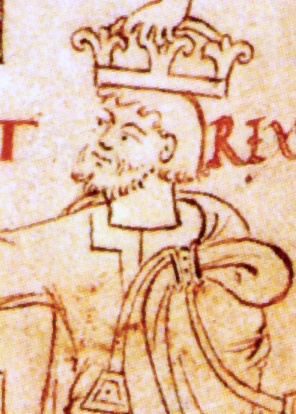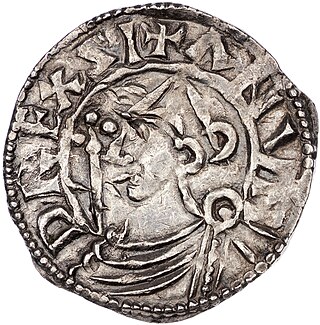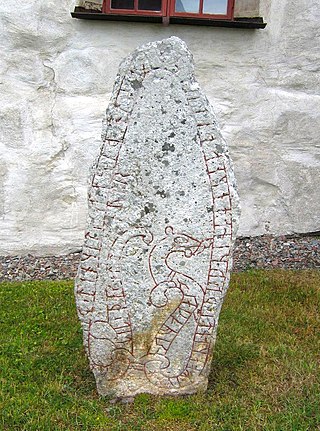See also
- Yakima Canutt (1895–1986), American champion rodeo rider, actor, stuntman and action director
Canute is an anglicisation of the Scandinavian name Knut. It may refer to:
Medieval era:
Modern world:

Year 1035 (MXXXV) was a common year starting on Wednesday of the Julian calendar.

Emma of Normandy was a Norman-born noblewoman who became the English, Danish, and Norwegian queen through her marriages to the Anglo-Saxon king Æthelred the Unready and the Danish king Cnut the Great. A daughter of the Norman ruler Richard the Fearless and Gunnor, she was Queen of the English during her marriage to King Æthelred from 1002 to 1016, except during a brief interruption in 1013–14 when the Danish king Sweyn Forkbeard occupied the English throne. Æthelred died in 1016, and Emma married Sweyn's son Cnut. As Cnut's wife, she was Queen of England from their marriage in 1017, Queen of Denmark from 1018, and Queen of Norway from 1028 until Cnut died in 1035.

Harthacnut, traditionally Hardicanute, sometimes referred to as Canute III, was King of Denmark from 1035 to 1042 and King of the English from 1040 to 1042.

Sweyn Forkbeard was King of Denmark from 986 until his death, King of England for five weeks from December 1013 until his death, and King of Norway from 999/1000 until 1013/14. He was the father of King Harald II of Denmark, King Cnut the Great, and Queen Estrid Svendsdatter.

Cnut, also known as Canute and with the epithet the Great, was King of England from 1016, King of Denmark from 1018, and King of Norway from 1028 until his death in 1035. The three kingdoms united under Cnut's rule are referred to together as the North Sea Empire.

Magnus Olafsson, better known as Magnus the Good, was King of Norway from 1035 and King of Denmark from 1042 until his death in 1047.

Olaf II Haraldsson, later known as Saint Olaf and Olaf the Holy, was King of Norway from 1015 to 1028. Son of Harald Grenske, a petty king in Vestfold, Norway, he was posthumously given the title Rex Perpetuus Norvegiae and canonised at Nidaros (Trondheim) by Bishop Grimketel, one year after his death in the Battle of Stiklestad on 29 July 1030. His remains were enshrined in Nidaros Cathedral, built over his burial site. His sainthood encouraged the widespread adoption of Christianity by Scandinavia's Vikings/Norsemen.

Canute IV, later known as Canute the Holy or Saint Canute, was King of Denmark from 1080 until 1086. Canute was an ambitious king who sought to strengthen the Danish monarchy, devotedly supported the Roman Catholic Church, and had designs on the English throne. Slain by rebels in 1086, he was the first Danish king to be canonized. He was recognized by the Roman Catholic Church as patron saint of Denmark in 1101.
Knut, Knud (Danish), or Knútur (Icelandic) is a Scandinavian and German first name, of which the anglicised form is Canute. In Germany both "Knut" and "Knud" are used. In Spanish and Portuguese Canuto is used which comes from the Latin version Canutus, and in Finland, the name Nuutti is based on the name Knut. The name is derived from the Old Norse Knútr meaning "knot". In English the K is not mute, so the name is not pronounced nut or nute.
Gytha Thorkelsdóttir, also called Githa, was a Danish noblewoman. She was the wife of Godwin, Earl of Wessex, and the mother of King Harold Godwinson and Edith of Wessex, the latter of whom was the queen consort of King Edward the Confessor.

Anund Jacob or James was King of Sweden from 1022 until around 1050. He is believed to have been born on 25 July, in either 1008 or 1010 as Jakob, the son of King Olof Skötkonung and Queen Estrid. Being the second Christian king of the Swedish realm, his long and partly turbulent reign saw the increasing dissemination of Christianity as well as repeated attempts to influence the balance of power in Scandinavia. Throughout his reign, he tried to subvert the rising Danish hegemony in Scandinavia by supporting the Norwegian monarchy. He also supported the reign of Yaroslav the Wise in Kievan Rus, his brother-in-law. He is referred to in positive terms in German and Norse historical sources. His reign was one of the longest in Sweden during the Viking Age and Middle Ages.

Thorkell the Tall, also known as Thorkell the High in the Anglo-Saxon Chronicle, was a prominent member of the Jomsviking order and a notable lord. He was a son of the Scanian chieftain Strut-Harald, and a brother of Jarl Sigvaldi, Hemingr and Tófa. Thorkell was the chief commander of the Jomsvikings and the legendary stronghold Jomsborg, on the Island of Wollin. He is also credited as having received the young Cnut the Great into his care and taken Cnut on raids. The Encomium Emmae, a document aimed at the movers and shakers of the Anglo-Scandinavian court in the early 1040s, describes Thorkell as a great war leader and warrior.
Events from the 1020s in England.
Events from the 1010s in England.

The North Sea Empire, also known as the Anglo-Scandinavian Empire, was the personal union of the kingdoms of England, Denmark and Norway for most of the period between 1013 and 1042 towards the end of the Viking Age. This ephemeral Norse-ruled empire was a thalassocracy, its components only connected by and dependent upon the sea.

The House of Estridsen was a dynasty that provided the kings of Denmark from 1047 to 1412. The dynasty is named after its ancestor Estrid Svendsdatter. The dynasty is sometimes called the Ulfinger, after Estrid's husband, Ulf Jarl. The dynasty also provided three medieval rulers of Sweden and one of Norway. Their family coat of arms became the coat of arms of Denmark and therefore influenced the coat of arms of Tallinn and the coat of arms of Estonia.
Canute of Denmark - Danish: Knud - may refer to:

The Danish House of Knýtlinga was a ruling royal house in Middle Age Scandinavia and England. Its most famous king was Cnut the Great, who gave his name to this dynasty. Other notable members were Cnut's father Sweyn Forkbeard, grandfather Harald Bluetooth, and sons Harthacnut, Harold Harefoot, and Svein Knutsson. It has also been called the House of Canute, the House of Denmark, the House of Gorm, or the Jelling dynasty.

In the autumn of 1016, the Danish prince Cnut the Great (Canute) successfully invaded England. Cnut's father, Sweyn Forkbeard, had previously conquered and briefly ruled England for less than five weeks.
Events from the 11th century in Denmark.